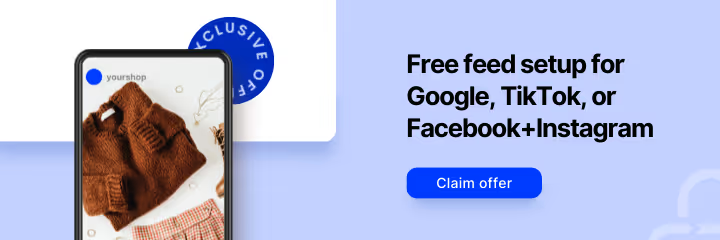You need a mix of smart segmentation and optimization strategies to get the best results from your Performance Max (PMax) Shopping campaigns. These approaches help your ads reach the right audience with the right message, boosting conversions and improving overall performance. Whether focusing on high-margin products, separating brand and non-brand traffic, or using ad extensions, these strategies will help you enhance your campaign effectiveness.
Let’s explore how these segmentation and optimization strategies can make your PMax Shopping campaigns more efficient and effective.
1. Focus on Top Performers and High Margins for Better Results

Focus on your best-selling and highest-margin products. This strategy makes sure your most profitable items get the most attention and ad spend, leading to more revenue.
Prioritizing high-margin products boosts your advertising return. Promoting items that make the most profit improves campaign efficiency and ensures a higher overall return.
Implementation Tips:
A. Align Queries with Product Ads
Make sure search queries match your top-performing products. This boosts conversions.
B. Analyze Conversion Data
Check regularly if your top products are driving sales. Don't just rely on clicks.
C. Optimize Product Listings
Use clear titles, descriptions, and images to attract and convert customers. High-quality listings improve click-through and conversion rates.
D. Monitor Performance
Keep an eye on your campaign's performance. Adjust targeting, creatives, or bids based on what you learn.
Focusing on top performers and high-margin segmentation helps you use your advertising budget wisely. Align queries, analyze data, and optimize listings to boost your PMax Shopping campaign performance.
[Learn how to optimize your Google Shopping product titles to improve visibility and conversions.]
2. Segment by Product Type for Sharper Targeting

Group similar products based on their categories or characteristics. This makes your advertising more targeted and effective.
When you group similar products, you get clearer data and more precise targeting. By segmenting products into well-defined categories, you can tailor your ads to the needs and behaviors of each group. This helps identify which product types perform best and optimizes your ad spend.
Implementation Tips:
A. Use Historical Performance Data
Check past performance data to group products effectively. See which product types have driven the most conversions and allocate resources to those categories.
B. Ensure Data Clarity
Keep clear and distinct groupings for your products. Avoid mixing unrelated items to ensure accurate data and better-targeted ads.
C. Optimize for Relevance
Tailor your ad creatives and messages to each product type's characteristics. This makes your ads resonate more with potential customers, increasing conversions.
D. Monitor Performance
Keep an eye on how each product type segment performs. Adjust your strategy based on data insights.
Grouping similar products helps create more targeted and effective ads. By using historical data, maintaining clear groupings, and optimizing for relevance, you can make your PMax Shopping campaigns more successful.
[Discover how to segment and customize your product feeds to target different product types more effectively and improve ad performance.]
3. Expand Reach and Increase Conversions by Separating Branded and Non-Branded Traffic
Separate traffic based on whether users are searching for brand-related terms or generic queries. This helps tailor your ads to different user intents, making them more relevant and effective.
You can target and budget more precisely when you distinguish between brand and non-brand traffic. Branded searches often show higher intent and familiarity with your products, leading to higher conversion rates. Non-branded searches can attract new customers who aren’t familiar with your brand yet, expanding your reach.
Implementation Tips:
A. Analyze Search Intent
Understand the intent behind searches. Brand searches are usually closer to purchase, while non-brand searches may be more exploratory.
B. Budget Allocation
Allocate a higher budget to brand searches because they have higher conversion potential. But keep a presence in non-brand searches to attract new customers.
C. Tailored Messaging
Create different ads for brand and non-brand segments. Highlight brand-specific benefits in brand ads, and focus on broader product benefits in non-brand ads.
D. Monitor Performance
Regularly review how each segment performs and adjust your strategies based on the data.
Using brand and non-brand segmentation helps you target different user intents more effectively. By understanding search intent, allocating budgets wisely, and tailoring your messaging, you can optimize your PMax Shopping campaigns to convert both brand-aware customers and new prospects.
4. Focus on High-Value Customers for Optimal Segmentation

Focus on identifying and targeting high-value customers who contribute most to your revenue over time. This strategy helps you acquire and keep the most profitable customers.
When you segment customers by their acquisition cost and lifetime value, you optimize your marketing spend. By targeting customers with the highest LTV compared to their acquisition cost, you improve your ROI and build sustainable revenue. This approach also allows for more personalized marketing, boosting customer loyalty and retention.
Implementation Tips:
A. Analyze Customer Data
Look at purchase history, frequency, and average order value to find high-value segments.
B. Target High-LTV Customers
Spend more on acquiring and keeping customers with the highest LTV. Use tailored ads and offers for this group.
C. Monitor and Adjust
Regularly review your segmentation strategy. Adjust targeting and budget based on performance data to keep attracting and retaining high-value customers.

Segmenting by nCAC and LTV helps you focus your ads on the most profitable customers. By analyzing customer data, targeting high-LTV customers, and adjusting your strategy, you can make your PMax Shopping campaigns more efficient and effective.
5. Improve Ad Performance with Asset Groups and Audience Signals
Asset groups and audience signals are key parts of PMax for Shopping campaigns. Asset groups are collections of creative elements like images, videos, headlines, and descriptions centered around a theme or target audience. Audience signals help guide Google’s AI to understand which audiences are most likely to convert, making your campaigns more effective.
Using asset groups and audience signals lets you create more tailored and relevant ads. This personalization boosts user engagement and increases conversions. Asset groups keep your creative assets organized and effective, while audience signals refine targeting to reach the right users.
Implementation Tips:
A. Create Diverse Asset Groups
Develop multiple asset groups based on different themes or audience segments. This ensures your ads are relevant and engaging in different contexts.
B. Use High-Quality Creatives
Make sure all assets—images, videos, headlines, and descriptions—are high quality and match the intended message. High-quality creatives improve user engagement and conversion rates.
C. Leverage Audience Signals
Use demographics, interests, and past behaviors to guide Google’s AI in targeting. Detailed audience signals help the AI optimize ad delivery and improve performance.
D. A/B Testing
Regularly perform A/B testing on different creative combinations within asset groups and audience signals to find the most effective setups for your target audience.
Incorporating asset groups and audience signals into your PMax Shopping campaigns helps you deliver more personalized and effective ads. By creating diverse asset groups, using high-quality creatives, and leveraging audience signals along with A/B testing, you can improve targeting precision and boost overall campaign performance.
6. Optimize Your Budget by Tweaking Campaign Settings and Exclusions

Fine-tuning your campaign settings and using exclusions are key to optimizing PMax Shopping campaigns. Proper settings make sure your ads target effectively, while exclusions prevent wasted budgets on low-performing products and irrelevant keywords.
Adjusting settings and exclusions can improve your ad efficiency. By excluding non-profitable products and irrelevant search terms, you ensure your budget goes to high-potential areas, maximizing ROI. This approach also speeds up the learning phase, leading to faster optimization and better results.
Implementation Tips:
A. Use Listing Groups for Product Exclusions
Exclude low-performing or low-margin products using listing groups based on brand, product ID, or custom labels. Focus your budget on items more likely to convert.
B. Apply Keyword Exclusions
Use negative keywords to filter out irrelevant search queries. This saves your budget and improves targeting accuracy.
C. Optimize Campaign Settings
Regularly review and adjust settings like location targeting, language preferences, and ad scheduling to match your campaign goals and audience behavior.
D. Monitor Performance
Keep an eye on performance metrics to ensure your settings and exclusions work effectively. Adjust them as needed based on data insights.Effective use of campaign settings and exclusions can streamline your PMax Shopping campaigns, ensuring your ads reach the right audiences and your budget is used wisely. By using listing groups and keyword exclusions, and fine-tuning other settings, you can enhance campaign performance and get better results.
[Read how using import rules and exclusions can streamline your PMax campaigns and optimize budget allocation.]
7. Transform Your Campaigns with Precision Bidding Approaches
Bidding strategies determine how you spend your budget and impact your PMax Shopping campaigns. Picking the right strategy helps you meet your goals, whether it’s getting more conversions, increasing conversion value, or hitting a target return on ad spend (ROAS).
Choosing the right bidding strategy aligns your budget with your campaign goals. This ensures your ad spend is used effectively to increase sales or maximize revenue. Bidding strategies also make your campaigns more efficient, getting the most value from your budget.
Implementation Tips:
A. Maximize Conversions
Focus on getting the highest number of conversions within your budget. This is ideal if you want to increase the total number of sales or leads.
B. Maximize Conversion Value
Aim to get the most value from each conversion. This strategy works well if you want fewer but more valuable conversions, optimizing for revenue.
C. Target CPA (Cost Per Acquisition)
Set a specific cost per conversion. This is useful when you know how much you’re willing to pay for each conversion and want to keep costs stable.
D. Target ROAS (Return on Ad Spend)
Aim for a specific return on ad spend. This is beneficial if you have a revenue target for each dollar spent and want to ensure your campaigns meet or exceed that target.
E. Monitor Performance
Regularly check and adjust your bidding strategies based on how your campaigns are performing. This helps keep your campaigns aligned with your goals.
Picking the right bidding strategy is key to successful PMax Shopping campaigns. By matching your strategy with your goals, you can make sure your budget is used wisely and your campaigns deliver the results you want.
8. Ad Extensions: Boost Your Engagement Rates

Ad extensions add extra information to your ads, giving users more reasons to click. They include site links, callouts, structured snippets, and more, making your ads more useful and engaging.
Using ad extensions boosts the visibility and appeal of your ads. They provide extra details and improve your ad quality score, which can lead to higher rankings and better performance. Extensions make your ads stand out, increasing the chances of attracting potential customers.
Implementation Tips:
While you can't directly add traditional ad extensions like in other campaign types, you can ensure that your PMax campaigns make the most of the available features. Here's how:
A. Optimize Your Product Feed
Ensure your product feed is complete and accurate with high-quality images and detailed descriptions. This enhances ad relevance and performance.
B. Use Diverse Asset Groups
Provide a variety of creative assets in your campaign’s asset groups to give Google's algorithm more options to create engaging and effective ads.
C. Monitor and Adjust Regularly
Regularly review the performance of your PMax campaign assets and adjust your assets and product feed accordingly to improve results.
While traditional ad extensions are not manually added to PMax Shopping campaigns, the structure and automated features of PMax effectively cover similar functionalities, ensuring your ads are comprehensive and engaging across all of Google's platforms.
Adding ad extensions to your PMax Shopping campaigns can greatly improve the visibility and effectiveness of your ads. By providing extra, relevant information through site links, callouts, structured snippets, and other extensions, you can boost user engagement and drive more conversions.
[Check out best practices for optimizing Google Merchant Center feeds to ensure accurate data and high-quality ad performance.]
Summary
Combining smart segmentation and optimization strategies is key to successful PMax Shopping campaigns. Focus on high-margin products, product types, brand vs. non-brand traffic, and high-value customers to target your ads better. Use asset groups, audience signals, campaign settings, exclusions, bidding strategies, and ad extensions to boost your ad performance. These tactics ensure your ads reach the right audience, increase conversions, and improve overall results.
Analyze your product data, refine your audience targeting, and optimize your ad settings. Following these best practices drives higher engagement, boosts conversions, and achieves greater success in your campaigns.






%20).webp)